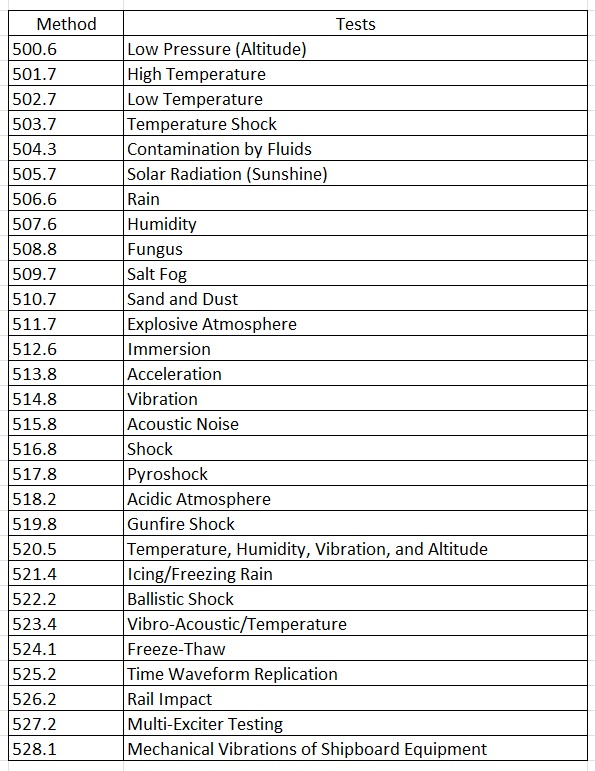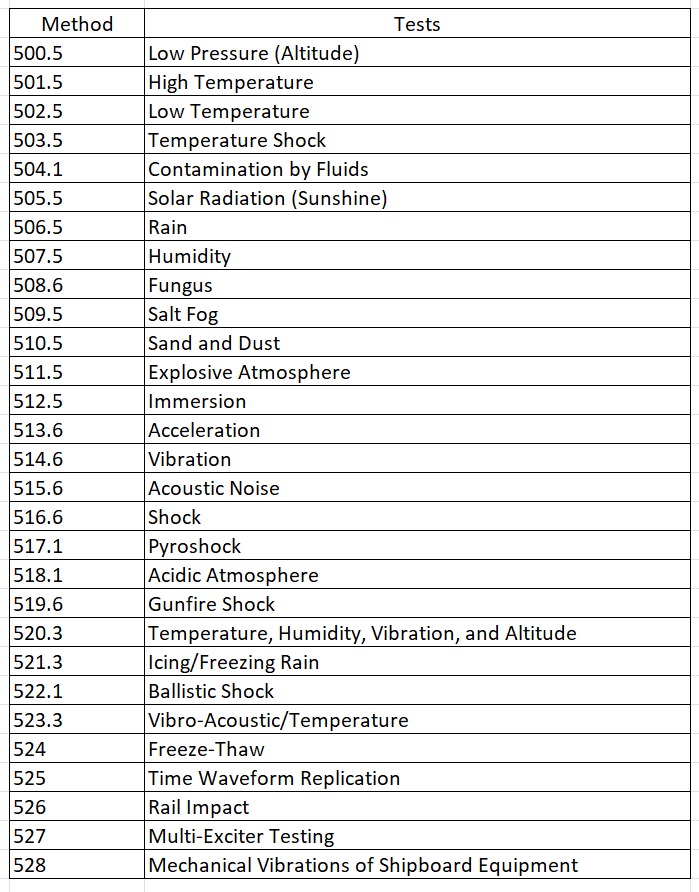MIL-STD-810 HISTORY AND FORMATION
– MIL-STD (Military Standard) stands for Military Standard.
– MIL STD 810 is a set of various tests designed by the US military to test equipment specifications in use (environment) or in storage (shocks).
– The test apparatus varies according to the specifications, size, and weight of the equipment being tested.
– The MIL-STD-810 test method standard is a distribution provided by the US Department of Defense with contributions from the US Army, Air Force, and Navy, as well as the Institute of Environmental Sciences and Technology (IEST).
– The initial version of MIL-STD-810 was released in 1962.
– Revisions were made alphabetically, and MIL-STD-810G, revised in 2008, is still widely used.
– MIL-STD-810H was published in January 2019.
– In 2022, MIL-STD-810G (with CHANGE-1) was published.
MIL-STD-810 PURPOSE AND SCOPE
The MIL-STD 810 Standard consists of 29 laboratory test methods used to test the ruggedness of materials.
A portion of the 1,089-page MIL-STD-810H document defines the purpose of MIL-STD-810 as “systemically considering potential harmful entities over the service life of a specific material system in various markets.”
In simpler terms, the purpose of MIL-STD-810 is:
Identification of environmental life series, equipment, and equipment operating life.
Analyzing and developing the test by adapting the test sample to the working environment in the field.
Demonstrating compliance of the test sample with the required conditions and evaluation under the required life cycles.
Identifying deficiencies and defects in test sample design, production parts, packaging techniques, and maintenance programs.
MIL STD 810G TEST SCOPES
MIL-STD-810 G is a Defense Test method standard consisting of 3 sections, 29 methods, and 3 appendices totaling 804 pages of Environmental Tests.

MIL-STD-810H TEST SCOPE
MIL-STD-810H is a Defense Test method standard consisting of 3 sections, 29 methods, and 3 appendices totaling 1,089 pages of Environmental Tests.

Sure, here is the translation of each point:
1. **Definition of Temperature Shock:**
– **MIL-STD-810H 503.7 Temperature Shock:** A. Selection of standard variations, B. Determination of test levels and conditions, C. Test duration (number of shocks), D. Interruption due to test equipment failure, E. Pre-test standard ambient control.
2. **Main Plan Testing:**
– **MIL-STD-810H 504.3 Contamination with Liquids:** Pre-test standard ambient control and controls.
3. **Test Conditions and Tolerances:**
– **MIL-STD-810H 505.7 Solar Radiation:** A. Limitations, B. Spectral power distribution, C. Final test, D. Test facility, E. Solar radiation source and test parameter tolerances.
4. **Calibration Interval Guidelines:**
– **MIL-STD-810H 506.6 Rain:** A. Droplet size, B. Water pressure, C. Pre-test, D. Final test, E. Interruption due to testing.
5. **Temperature Change Rate:**
– **MIL-STD-810H 508.8 Fungus:** A. Purpose and application, B. Limitations, C. International interference, D. Fungus selection, E. Pre-test, Final test, Test room, F. Air velocity.
6. **Low Pressure (Altitude) Test and Temperature:**
– **MIL-STD-810H 509.7 Salt Fog:** A. Spray rate, B. Salt fog collection vessels and reference documents.
7. **High Temperature Testing I and II:**
– **MIL-STD-810H 510.7 Sand and Dust:** A. Purpose, limitations, Effects of sand and dust environments, B. Sequence among other methods and selection of expenditures, C. Pre-test, During test and Final test, D. Temperature, air velocity, and dust composition.
8. **MIL-STD-810H 511.7 Explosive Atmosphere:** Fuel, Final test, and Test facility.
9. **MIL-STD-810H 512.6 Immersion:** Pre-test and Scope I – Immersion.
10. **MIL-STD-810H 513.8 Acceleration:** Acceleration and shock, Climate conditioning, Selection of criteria, Selection considerations, Strength test, Test axes.
11. **MIL-STD-810H 514.8 Vibration:** A. Application, limitations, Pre-test, Acceleration input control strategy, B. Random vibration test tolerances, C. Sinusoidal vibration test tolerances, and completion III – Large assembly transportation.
12. **MIL-STD-810H 515.8 Acoustic Oil:** Calibration and Tolerance and Table 515.8AI. General Sound Pressure Levels and Durations.
13. **MIL-STD-810H 518.2 Acidic Atmosphere:** Chemical composition and concentration.
14. **MIL-STD-810H 522.2 Ballistic Shock:** Controls/Tolerances.
15. **MIL-STD-810H 523.4 Vibro-Acoustic/Temperature:** Temperature, shock, ranking among other methods, Pre-test, Controls/Tolerances.
